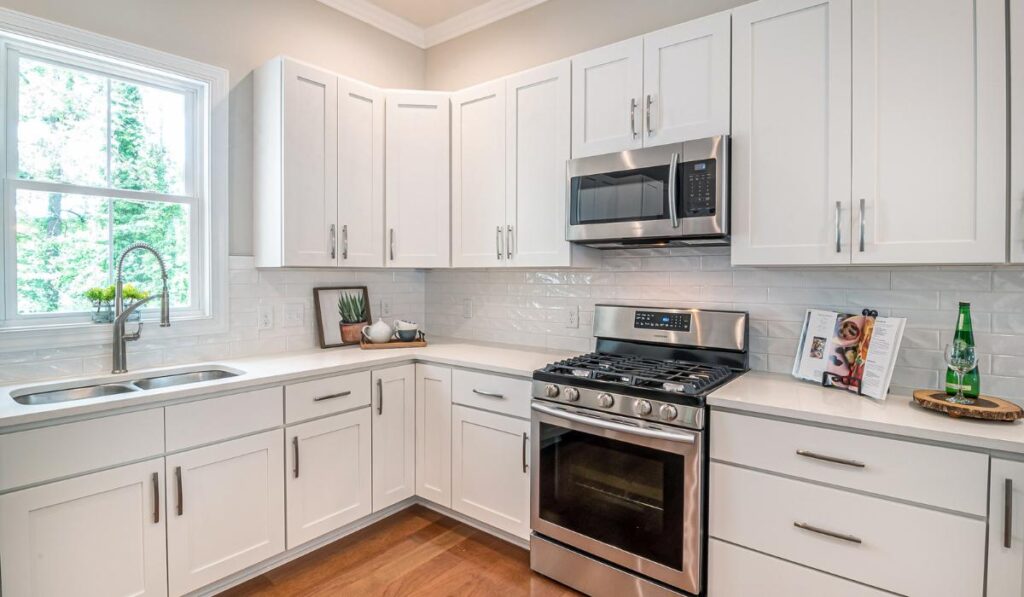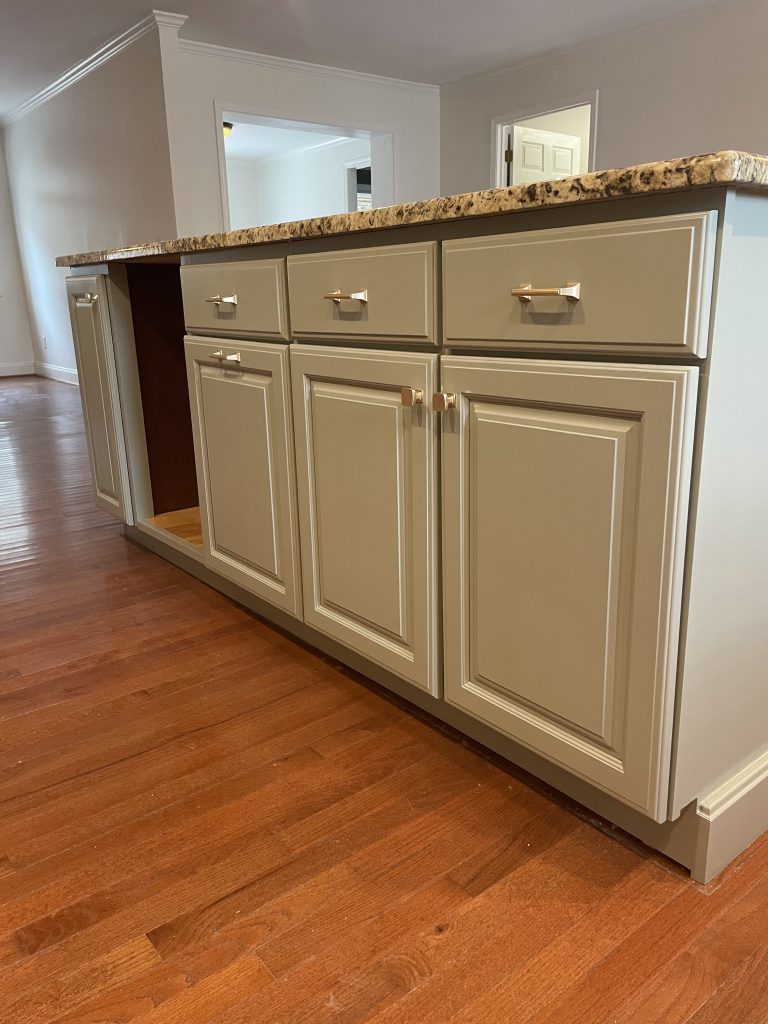Painted cabinets can completely transform a kitchen or bathroom, giving the space a fresh, updated look. But keeping them clean? That’s a different challenge. Grease, food splatters, fingerprints, and dust build up quickly, leaving cabinets looking dull and grimy.
That’s where the cleaning dilemma begins. Should you trust a DIY cleaner with natural ingredients, or is a store-bought commercial cleaner the better option?
Common Homeowner Concerns:
- “Will a DIY cleaner be strong enough to remove grease?”
- “Are store-bought cleaners too harsh and will they damage my cabinets?”
- “What’s the safest option for my family and the environment?”
This guide will break down both cleaning methods, their pros and cons, and when it might be time to call in a professional.
Understanding Painted Cabinet Surfaces: Why the Right Cleaner Matters

Different Paint Finishes and Their Cleaning Needs
Not all painted cabinets are the same, and their finish affects how they should be cleaned.
- Matte or Chalk-Finish Cabinets – These absorb more dirt and grease, making them harder to clean. They require extra care and gentle cleaning solutions.
- Satin or Eggshell Cabinets – More stain-resistant than matte finishes but still sensitive to strong chemicals. A mild cleaner works best.
- Semi-Gloss or High-Gloss Cabinets – These are the easiest to clean because of their smooth surface, but they can show streaks if cleaned with harsh chemicals.
Risks of Using the Wrong Cleaner
- Too Harsh – Strong chemicals can strip paint, cause discoloration, or dull the finish over time.
- Too Weak – Ineffective cleaners won’t fully remove grease, allowing buildup that becomes harder to clean later.
- Too Moisture-Rich – Excess water can seep into the paint, leading to peeling or bubbling over time.
Using the right cleaner is essential to keeping your painted cabinets looking great while avoiding damage.
DIY Cabinet Cleaners: Pros, Cons, and Best Recipes
Many homeowners turn to DIY cleaners for painted cabinets because they offer a natural, budget-friendly, and customizable alternative to store-bought products. However, while these homemade solutions can be effective for routine maintenance, they do have limitations. Understanding the benefits and drawbacks of DIY cleaners will help you decide if they are the right choice for your cabinets.
Why Some Homeowners Prefer DIY Cleaners
One of the biggest advantages of DIY cleaners is their use of natural ingredients. This makes them a safer choice for families with young children, pets, or anyone with chemical sensitivities.
Cost is another major factor. DIY cabinet cleaners are budget-friendly because they rely on inexpensive, readily available ingredients. Instead of buying multiple commercial cleaning products, homeowners can use a few basic staples they likely already have.
Another reason homeowners choose homemade cleaners is that they are customizable. If a cabinet finish is particularly delicate, you can tweak the formula by adjusting ingredient ratios. The ability to control what goes into the cleaner means you can tailor it to suit the specific needs of your painted cabinets.
For homeowners who prefer a natural approach, these DIY cleaning solutions can handle everyday dirt, grease, and even stubborn stains while being gentle on painted cabinet surfaces.
Everyday Gentle Cleaner (for light dirt & fingerprints)
A simple dish soap and water mixture is often enough to keep painted cabinets looking clean. This mild solution effectively removes dust, fingerprints, and light smudges without stripping paint or leaving behind residue.
Ingredients:
- 1 cup warm water
- A few drops of mild dish soap
- Soft microfiber cloth
Instructions:
- Dip a microfiber cloth into the solution and wring it out until damp (not soaking wet).
- Wipe the cabinets in a circular motion, focusing on high-touch areas.
- Dry immediately with a clean cloth to prevent streaks.
DIY Degreaser (for tough grease buildup)
Kitchen cabinets near the stove tend to collect a sticky layer of grease over time. This DIY degreaser helps cut through buildup without damaging the paint.
Ingredients:
- 1 cup warm water
- ½ cup white vinegar
- A few drops of dish soap
Instructions:
- Mix ingredients in a spray bottle or bowl.
- Dampen a cloth with the solution and gently scrub greasy areas.
- Rinse with a damp cloth and dry immediately.
Baking Soda Paste (for stubborn stains)
Baking soda is a mild abrasive that helps lift tough stains without being too harsh on painted cabinets. However, it should be used with caution—scrubbing too hard can wear down the paint over time.
Ingredients:
- 1 tbsp baking soda
- A few drops of water
Instructions:
- Mix baking soda and water until it forms a thick paste.
- Apply a small amount to the stain and gently rub with a soft cloth.
- Wipe clean with a damp cloth and dry.
Downsides of DIY Cabinet Cleaners
While DIY cleaners are a great alternative for light cleaning, they do have some drawbacks.
Vinegar can dull or damage certain paint finishes over time. Though it’s a great natural degreaser, its acidic nature can break down the protective coating on some painted surfaces, especially if used too often.
Baking soda can be abrasive if scrubbed too hard. While effective for stain removal, excessive scrubbing can lead to micro-scratches, which may cause painted cabinets to lose their smooth finish.
DIY cleaners may not be strong enough for heavy-duty grease buildup. If cabinets haven’t been cleaned in a long time, homemade solutions may not be powerful enough to cut through thick layers of grease and grime. In these cases, a commercial cleaner might be necessary.
Short shelf life requires fresh batches each time. Unlike store-bought cleaners, which are formulated for long-term storage, most DIY mixtures need to be made fresh before each use. This can be inconvenient for those who prefer a grab-and-go cleaning solution.
Store-Bought Cabinet Cleaners: Pros, Cons, and Best Brands

Why Some Homeowners Prefer Commercial Cleaners
One of the main reasons people choose commercial cleaners is that they are formulated specifically for painted surfaces. Unlike DIY mixtures, which can sometimes be too acidic or abrasive, store-bought cleaners are designed to clean effectively without stripping paint, dulling finishes, or causing long-term damage.
Commercial cleaners are also more powerful against grease. In kitchens, where cabinets are constantly exposed to cooking oils and airborne grease, a stronger cleaner is often necessary.
Another key advantage is convenience. There’s no need to mix ingredients, measure out the perfect ratio, or worry about making a fresh batch every time you clean. Just grab the bottle, spray, and wipe—it’s that simple. For busy homeowners, this time-saving factor makes a big difference.
Best Store-Bought Cabinet Cleaners
If you’re considering a commercial cleaner for your painted cabinets, choosing the right product is important. Some cleaners contain harsh chemicals that can degrade paint over time, while others are gentle and safe for regular use. Here are some of the best options available:
Murphy’s Oil Soap
A trusted name in wood care, Murphy’s Oil Soap is a gentle yet effective cleaner that’s safe for painted cabinets. It helps lift dirt and grease without leaving behind residue, making it a great everyday option.
Method All-Purpose Cleaner (Wood Safe Version)
This non-toxic, eco-friendly cleaner is safe for painted surfaces and contains plant-based ingredients. It’s a great choice for homeowners who want a commercial cleaner without harsh chemicals.
Simple Green All-Purpose Cleaner
Simple Green is known for being tough on grease but gentle on surfaces. It effectively removes grime without stripping the paint, making it ideal for kitchen cabinets that see heavy use.
Bona Cabinet Cleaner
Designed specifically for painted wood surfaces, Bona Cabinet Cleaner cleans without dulling or damaging the finish. It’s a great option for cabinets with a delicate or high-gloss paint finish.
Downsides of Store-Bought Cleaners
While commercial cleaners offer convenience and power, they aren’t perfect. Here are some drawbacks to consider before making them your go-to choice for painted cabinets.
Some products contain harsh chemicals. While many cleaners are designed to be safe for painted surfaces, others contain strong solvents that can gradually wear down the paint over time. It’s important to check labels and choose a formula that’s paint-safe.
Strong fragrances may cause irritation. Some store-bought cleaners have added fragrances that can be overwhelming, especially for people with allergies or sensitivities. If you prefer a milder scent, look for fragrance-free or naturally scented options.
Higher cost compared to DIY solutions. Commercial cleaners tend to be more expensive than homemade alternatives. While a single bottle can last a while, the cost adds up over time—especially for homeowners who clean their painted cabinets frequently.
DIY vs. Store-Bought Cleaners: Which One is Best for You?
| Feature | DIY Cleaners | Store-Bought Cleaners |
|---|---|---|
| Cost | Extremely cheap, using household staples like vinegar, baking soda, and dish soap. Ideal for budget-conscious homeowners who don’t mind frequent mixing. | More expensive upfront (typically $5-$15 per bottle), but lasts longer since you use less per cleaning session. A good option for those prioritizing long-term convenience. |
| Effectiveness on Grease | Works well for light grease and everyday grime. However, DIY options like vinegar-based solutions may struggle with heavy, sticky buildup in kitchens where cabinets are exposed to oil splatters and steam. | Formulated to break down tough grease quickly. Products like Simple Green All-Purpose Cleaner and Bona Cabinet Cleaner are specifically designed to cut through stubborn kitchen grease without damaging painted surfaces. |
| Eco-Friendliness | 100% natural ingredients, no synthetic chemicals. Safe for homes with children and pets. However, vinegar and baking soda can alter certain finishes over time. | Varies by brand. Options like Method All-Purpose Cleaner (Wood Safe Version) are plant-based and non-toxic, but others contain artificial solvents and fragrances that may not be environmentally friendly. |
| Ease of Use | Requires measuring and mixing fresh batches each time. Some solutions (like baking soda paste) need extra rinsing to prevent residue. Best for homeowners willing to put in a little extra effort. | Ready to use straight from the bottle. No prep or mixing needed. A quick and efficient solution for busy households that need fast results. |
| Surface Safety | Generally safe for most painted cabinets, but vinegar can dull matte finishes over time, and baking soda can be too abrasive if scrubbed aggressively. Requires caution. | Specifically designed for painted surfaces. Brands like Murphy’s Oil Soap and Bona Cabinet Cleaner ensure that paint stays intact and glossy, making them a safer long-term choice. |
Which One Should You Choose?
- Go for DIY cleaners if you prefer a budget-friendly, eco-conscious approach and don’t mind a bit of extra effort. They work well for general maintenance and light dirt but may not be strong enough for deep cleaning.
- Choose a store-bought cleaner if you want a more powerful, hassle-free solution for grease and grime, especially in kitchens. While they cost more, they provide stronger cleaning power and long-term surface protection.
If you have high-end painted cabinets or frequently deal with kitchen grease, a commercial cleaner might be the better investment. But for everyday dust and fingerprints, a DIY solution could be all you need.
Step-by-Step Guide: Cleaning Painted Cabinets Safely

Daily Maintenance (To Prevent Buildup)
- Wipe down cabinets with a damp microfiber cloth after cooking.
- Avoid using excess water – always dry cabinets after wiping.
- Use a mild dish soap solution weekly for routine cleaning.
Deep Cleaning (For Grease and Stains)
- Choose a DIY Vinegar Degreaser or a store-bought cabinet cleaner.
- Apply onto a cloth (never spray directly on cabinets).
- Wipe in small sections, using gentle circular motions.
- Use a clean damp cloth to remove residue.
- Buff dry immediately with a soft, dry microfiber cloth.
Extra Protection for Painted Cabinets
- Apply Murphy’s Oil Soap for an extra layer of protection.
- Use cabinet bumpers to reduce fingerprint buildup.
- Keep range hood fans running while cooking to minimize grease deposits.
When to Call a Professional for Cabinet Cleaning or Refinishing
There are times when cleaning alone is not enough. If cabinets have heavy grease buildup that won’t come off, appear dull or discolored, or show signs of water damage such as peeling or bubbling paint, professional help may be needed.
Hiring a professional ensures that cabinets are cleaned deeply without risk of damage. Professionals also provide services such as paint touch-ups, refinishing, and applying protective coatings that extend the lifespan of the cabinets. If cabinets are too worn for cleaning to restore them, refinishing or repainting may be the best solution.
Conclusion: Which Cleaner Should You Use?
For everyday cleaning, a simple dish soap and water solution or a mild store-bought cleaner works well. For deep cleaning, store-bought cleaners are typically more effective against grease, but eco-friendly DIY solutions can be a good alternative. When cabinets show signs of significant wear, professional refinishing may be necessary.
Regular maintenance and choosing the right cleaning method will help keep painted cabinets looking fresh for years. If a deeper restoration is needed, reach out to us, and let’s make your cabinet look the best it has ever been.

